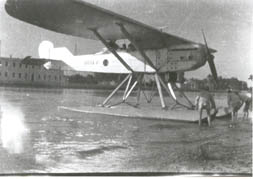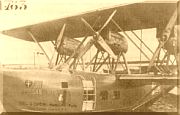| CANT 23 | |
|---|---|
 | |
| Role | Airliner |
| National origin | Italy |
| Manufacturer | CANT |
| First flight | 11 July 1932 |
| Number built | 1 |
| Developed from | CANT 22 |
The CANT 23 was an Italian trimotor airliner built by CANT in the late 1920s.
| CANT 23 | |
|---|---|
 | |
| Role | Airliner |
| National origin | Italy |
| Manufacturer | CANT |
| First flight | 11 July 1932 |
| Number built | 1 |
| Developed from | CANT 22 |
The CANT 23 was an Italian trimotor airliner built by CANT in the late 1920s.
The CANT 23 was an entirely metallic aircraft with a conventional look, a three-engine, biplane with a fixed trolley. The fuselage, with a rectangular section, was made of duraluminium and was characterized by a closed passenger compartment equipped with 10 single armchairs that overlooked a series of 5 rectangular windows on each side. The cockpit was external, placed on the upper part in front of the wings in an open cockpit protected by a windshield. The wing configuration was biplane-sesquiplane with the upper wing, more open, connected to the lower, considerably smaller, thanks to a Warren truss configuration. Both were made with a structure of side members in profile and ribs in square section tube covered in painted canvas.
In 1927 the airline company Società Italiana Servizi Aerei (SISA), a company owned by the brothers Callisto and Alberto Cosulich as well as the CRDA, had begun to operate on the route that joined the Italian Trieste with Budapest, capital of the then Kingdom of Hungary. In anticipation of an increase in demand from the air transport market with the possibility of making new connections to Central and Eastern Europe and in particular the opening of a route capable of connecting Trieste airport - Ronchi dei Legionari or, alternatively, the new Noghere airport, then under construction near the village of Zaule, in Vienna to continue to Budapest.
The project, the first of the CRDA-CANT that was not a seaplane, was supervised by the engineer Raffaele Conflenti, who at that time held the position of chief designer and director of the technical office of the company of Monfalcone, which took experience gained in the creation of the CANT 22 hydro line. The new aircraft, designated CANT 23, appeared to possess a conventional appearance and presented a new, for the company, fuselage made of duralumin characterized by the closed passenger compartment and an open cockpit for the pilot. The veiling and the three- engine propulsion in the tractor configuration were substantially similar to the previous CANT 22. The construction of the aircraft began as early as 1927, but its progress was not so fast, continuing until the beginning of the 1930s . [3] In 1929 a cell was created for static tests but the prototype, serial number NC.136, managed to be registered (I-ABLA) only on 11 July 1932. Although the design of CANT 23 benefited from all-metal construction, the constant development of the aeronautic industry determined the early technical aging of the model and definitively undermined any further development. The program was suspended on 1 May 1933 and the project was therefore abandoned. [1]
Data from [1]
General characteristics
Performance
Aircraft of comparable role, configuration, and era

The Fiat CR.20 was an Italian biplane fighter used during the 1920s and 1930s. Designed by Celestino Rosatelli, it represented an intermediate step from the early biplane CR.1 and the later, successful series CR.30, CR.32 and CR.42.

The Fiat CR.1 was an Italian biplane fighter aircraft of the 1920s. Of wood-and-fabric construction, it was designed by Celestino Rosatelli, from whom it gained the 'CR' designation. Its most distinctive feature was that the lower wings were longer than the upper ones.

The Breda A.7 was a reconnaissance aircraft developed in Italy for use by the Regia Aeronautica in 1929. It was a braced parasol monoplane of conventional configuration with tailskid undercarriage. The pilot and observer sat in tandem, open cockpits. A single prototype of a long-range example, originally designated A.7 Raid and later A.16 was also constructed, but the air force showed no interest in it.

The Breda A.9 was a biplane trainer produced in Italy in 1928 for the Regia Aeronautica. Conventional in design, it featured a single-bay, unstaggered wing cellule and fixed tailskid undercarriage. The student and instructor sat in tandem, open cockpits. A slightly smaller version, designated A.9-bis was developed for use in Italy's aeroclubs.

The SAI-Ambrosini SS.4 was an Italian fighter prototype developed in the late 1930s, featuring a canard-style wing layout and a pusher propeller. Development of the SS.4 was abandoned after the prototype crashed on its second flight.

The Savoia-Marchetti SM.78 was an Italian bomber/reconnaissance biplane flying boat of the early 1930s.

The Savoia-Marchetti SM.62 was an Italian single-engine maritime patrol flying boat produced from 1926. It served with the Regia Aeronautica and with a number of foreign users, and was licence-produced in Spain and the Soviet Union. Some of the Spanish aircraft were still in service during the Spanish Civil War
The Piaggio P.32 was an Italian medium bomber of the late 1930s, produced by Piaggio, and designed by Giovanni Pegna. It was a modern design for its time, but was a failure due to lack of powerplants commensurate with its high wing loading.

The CANT 26 was an Italian two-seat biplane trainer built by CANT.

The CANT 22 was a flying boat airliner built in Italy in the 1920s and operated by Società Italiana Servizi Aerei (SISA) on their Adriatic routes. It was a conventional biplane design with unstaggered wings braced by Warren trusses. The three engines were mounted in nacelles carried in the interplane gap. Accommodation for passengers was provided within the hull, but the pilots sat in an open cockpit. Originally designed to carry eight passengers, an engine upgrade on later examples allowed the addition of two more seats.

The Savoia-Marchetti S.59 was a 1920s Italian reconnaissance/bomber flying boat designed and built by Savoia-Marchetti for the Regia Aeronautica.

The twin-engined CANT Z.1011 was one of two bombers of about the same size and powered by the same engines, designed by Filippo Zappata in the mid-1930s. The other was the three-engined CANT Z.1007, which in the end was the type preferred by the Regia Aeronautica.

The Caproni Ca.124 was a 1930s single-engine Italian reconnaissance and bomber seaplane.
The Caproni Ca.61 was an Italian heavy day bomber aircraft of 1922. It was the final development of the Caproni three engine, twin boom biplane types developed during World War I, but it was not put into production.
The Caproni Ca.134 was a biplane reconnaissance aircraft built by the Italian company Caproni in the 1930s.
The CANT 12 was a flying boat and training aircraft that was produced in Italy in the 1920s.
The CANT 38 was a proposed reconnaissance/bomber biplane flying boat developed by CANT.

The CANT Z.505 was a prototype trimotor transport floatplane built by CANT in the 1930s.
The Caproni Ca.120 was a three-engine monoplane bomber built by Caproni in the 1930s.

The CANT 37 was an Italian reconnaissance flying boat built by CANT in the early 1930s.
| Wikimedia Commons has media related to CANT 23 . |